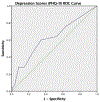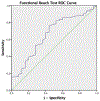Functional Reach, Depression Scores, and Number of Medications Are Associated With Number of Falls in People With Chronic Stroke
- PMID: 29288141
- PMCID: PMC7200172
- DOI: 10.1016/j.pmrj.2017.12.005
Functional Reach, Depression Scores, and Number of Medications Are Associated With Number of Falls in People With Chronic Stroke
Abstract
Background: Falls are a common adverse event among people with stroke. Previous studies investigating risk of falls after stroke have relied primarily on retrospective fall history ranging from 6-12 months recall, with inconsistent findings.
Objectives: To identify factors and balance assessment tools that are associated with number of falls in individuals with chronic stroke.
Design: Secondary analysis of a randomized clinical trial.
Setting: Multisite academic and clinical institutions.
Participants: Data from 181 participants with stroke (age 60.67 ± 11.77 years, post stroke 4.51 ± 4.78 years) were included.
Methods: Study participants completed baseline testing and were prospectively asked about falls. A multivariate negative binomial regression was used to identify baseline predictive factors predicting falls: age, endurance (6 minute walk test), number of medications, motor control (Fugl-Meyer lower extremity score), depression (Patient Health Questionnaire-9), physical activity (number of steps per week), and cognition (Mini Mental Status Exam score). A second negative binomial regression analysis was used to identify baseline balance assessment scores predicting falls: gait velocity (comfortable 10 Meter Walk), Berg Balance Scale (BBS), Timed Up and Go (TUG), and Functional Reach Test (FRT). Receiver operating characteristic (ROC) and area under the curve (AUC) were used to determine the cutoff scores for significant predictors of recurrent falls.
Main outcome measurement: The number of falls during the 42-week follow-up period.
Results: Baseline measures that significantly predicted the number of falls included increased number of medications, higher depression scores, and decreased FRT. Cutoff scores for the number of medications were 8.5 with an AUC of 0.68. Depression scores differentiated recurrent fallers at a threshold of 2.5 scores with an AUC of 0.62. FRT differentiated recurrent fallers at a threshold of 18.15 cm with an AUC of 0.66.
Conclusions: Number of medications, depression scores, and decreased FRT distance at baseline were associated with increased number of falls. Increased medications might indicate multiple comorbidities or polypharmacy effect; increased depression scores may indicate psychological status; and decreased functional reach distance could indicate dynamic balance impairments.
Level of evidence: II.
Trial registration: ClinicalTrials.gov NCT01138995.
Copyright © 2018 American Academy of Physical Medicine and Rehabilitation. Published by Elsevier Inc. All rights reserved.
Figures





References
-
- Kerse N, Parag V, Feigin VL, et al. Falls after stroke: Results from the Auckland Regional Community Stroke (ARCOS) Study, 2002 to 2003. Stroke 2008;39:1890–1893. - PubMed
-
- Mackintosh SF, Hill KD, Dodd KJ, Goldie PA, Culham EG. Balance score and a history of falls in hospital predict recurrent falls in the 6 months following stroke rehabilitation. Arch Phys Med Rehabil 2006;87:1583–1589. - PubMed
-
- Mackintosh SF, Hill K, Dodd KJ, Goldie P, Culham E. Falls and injury prevention should be part of every stroke rehabilitation plan. Clin Rehabil 2005;19:441–451. - PubMed
-
- Weerdesteyn V, de Niet M, van Duijnhoven HJ, Geurts AC. Falls in individuals with stroke. J Rehabil Res Dev 2008;45:1195–1213. - PubMed
Publication types
MeSH terms
Associated data
Grants and funding
LinkOut - more resources
Full Text Sources
Other Literature Sources
Medical
Research Materials

